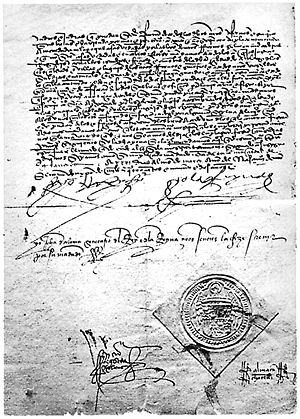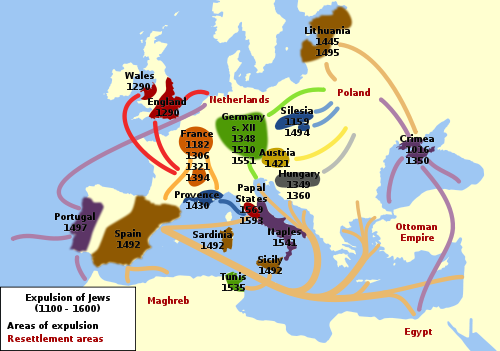- Alhambra Decree
-
Antisemitism 
History · Timeline · Resources OppositionCategoriesThe Alhambra Decree (also known as the Edict of Expulsion) was an edict issued on 31 March 1492 by the joint Catholic Monarchs of Spain (Isabella I of Castile and Ferdinand II of Aragon) ordering the expulsion of Jews from the Kingdom of Spain and its territories and possessions by 31 July of that year.[1]
The edict was formally revoked on 16 December 1968,[2] following the Second Vatican Council. Today, the number of Jews in Spain is estimated at 50,000.[3]
Contents
Background
Beginning in the 8th century, Muslims had occupied and settled most of the Iberian Peninsula. Jews, who had lived in these regions since Roman times, were considered "People of the Book"' and given special status and often thrived under Muslim rule. The tolerance of the Muslim Moorish rulers of al-Andalus attracted Jewish immigration, and Jewish enclaves in Muslim Iberian cities flourished as places of learning and commerce. Progressively, however, living conditions for Jews in al-Andalus became harsher, especially after the fall of the Muslim Umayyad Caliphate.
The Reconquista was the gradual reconquest of Islamic Iberia by the Catholic kingdoms with a powerful religious motivation: Iberia was being reclaimed for Christendom. By the 14th century, most of the Iberian Peninsula, present day Spain and Portugal, had been regained from the Moors.
Overt hostility against Jews became more pronounced, finding expression in brutal episodes of violence and oppression. Thousands of Jews sought to escape these attacks by converting to Catholicism; they were commonly called conversos, New Christians, or marranos. At first these conversions seemed an effective solution to the cultural conflict: many converso families met with social and commercial success. But eventually their success made these new Catholics unpopular with some of the clergy of the Church and royal hierarchies.
These suspicions on the part of Christians were only heightened by the fact that some of the coerced conversions were undoubtedly insincere. Some, but not all, conversos had understandably chosen to salvage their social and commercial prestige by the only option open to them – baptism and embrace of Christianity – while privately adhering to their Jewish practice and faith. These secret practitioners are commonly referred to as crypto-Jews or marranos.
The existence of crypto-Jews was a provocation for secular and ecclesiastical leaders who were already hostile toward Spain's Jewry. The uncertainty over the sincerity of Jewish converts added fuel to the fire of antisemitism in 15th-century Spain.
European context
Main article: Jews and Judaism in EuropeFrom the 13th to the 16th centuries many European countries expelled the Jews from their territory on at least 15 occasions, with Spain being preceded by England, France and Germany, among many others, and succeeded by at least five more expulsions. So Spain does not provide any exception to a tragic history of the life of Jews among Christian nations.[4]
Ferdinand and Isabella
The hostility toward Jews was brought to a climax by "the Catholic Monarchs" – Ferdinand II and Isabella I, whose marriage in 1469 formed a personal union of the crowns of Aragon and Castile, with coordinated policies between their distinct kingdoms.
Ferdinand and Isabella took seriously the reports that some crypto-Jews were not only privately practicing their former faith, but were secretly trying to draw other conversos back into the Jewish fold. In 1480 King Ferdinand devised and, with his wife, established the Spanish Inquisition in both Castile and Aragon to investigate these and other suspicions. It is not known how many had not truly converted, had lapsed from their new Christianity, or were attempting to persuade others to revert.
The independent Islamic Emirate of Granada had been a tributary state to Castile since 1238. In 1491, in preparation for an imminent transition to Castilian territory, the Treaty of Granada was signed by Emir Muhammad XII and the Queen of Castile, protecting the religious freedoms of the Jews and Muslims there. In 1492, Ferdinand and Isabella completed the Catholic Reconquista of the Iberian Peninsula from Islamic al-Andalus by victory in the Battle of Granada. In acquiring the city of Granada a large Jewish and Muslim population came under her rule. Soon Isabella and Ferdinand chose to replace the Treaty of Granada's Jewish protection terms with the Alhambra Decree's Inquisitional Castilian and Aragonite persecution.
The Decree
The king and queen issued the Alhambra Decree less than three months after the surrender of Granada. In it, Jews were accused of trying "to subvert their holy Catholic faith and trying to draw faithful Christians away from their beliefs." These measures were not new in Europe.[5]
Some Jews were even only given four months and ordered to convert to Christianity or leave the country. Under the edict, Jews were promised royal "protection and security" for the effective three-month window before the deadline. They were permitted to take their belongings with them – except "gold or silver or minted money".
The punishment for any Jew who did not convert or leave by the deadline was death. The punishment for a non-Jew who sheltered or hid Jews was the confiscation of all belongings and hereditary privileges.
Dispersal
The Spanish Jews who chose to leave Spain dispersed throughout the region of North Africa known as the Maghreb. They also fled to south-eastern Europe where they were granted safety and formed flourishing local Jewish communities, the largest being those of Salonica and Sarajevo. In those regions, they often intermingled with the already existing Mizrachi (Middle Eastern Jewish) communities.
Scholars disagree about how many Jews left Spain as a result of the decree; the numbers vary between 130,000 and 800,000. Many (likely more than half) went to Portugal, where they eluded persecution for only a few years (see Portuguese Inquisition). The Jewish community in Portugal (perhaps then some 10% of that country's population [6]) were then declared Christians by Royal decree unless they left, but since their departure was severely hindered by the King (who needed their expertise for Portugal's overseas enterprises), the vast majority was forced to stay as nominal Christians. [7] http://www.jewfaq.org/ashkseph.htm
Conversions
Other Spanish Jews (estimates range between 50,000 and 70,000)[citation needed] chose to avoid expulsion by conversion to Christianity. However, their conversion did not protect them from ecclesiastical hostility after the Spanish Inquisition came into full effect; persecution and expulsion were common. Many of these "New Christians" were eventually forced to either leave the countries or intermarry with the local populace by the dual Inquisitions of Portugal and Spain. Many settled in North Africa, Latin America [8] or elsewhere in Europe, most notably in the Netherlands, and England (see Sephardic Jews in the Netherlands, History of the Marranos in England).
However, recent[when?] Y chromosome DNA testing conducted by the University of Leicester and the Pompeu Fabra University has indicated that around 20% of Spanish men today have direct patrilineal descent from Sephardic Jews. The result is in contradiction [9][10][11][12][13] or not replicated in all the body of genetic studies done in Iberia and conflicts with mainstream historiography (denies Neolithic, Roman, Greek, Phoenician, Germanic, Alani, Slavic, Arab and other contributions to modern Iberians) and has been questioned by the authors themselves [14][15][16][17] and by Stephen Oppenheimer.[18]
Don Isaac Abravanel and the Alhambra decree
Legend does claim that Don Isaac Abravanel, who had previously ransomed 480 Jewish converts of Malaga from the Catholic monarchs by a payment of 20,000 doubloons, now offered them 600,000 ducats for the revocation of the edict. It is said also that Ferdinand hesitated, but was prevented from accepting the offer by Tomás de Torquemada, the grand inquisitor, who dashed into the royal presence and, throwing a crucifix down before the king and queen, asked whether, like Judas, they would betray their Lord for money.
The 1988 novel The Alhambra Decree by David Raphael contains a fictionalized response to the Alhambra decree attributed to Isaac Abrabanel. It is commonly (and mistakenly) cited as genuine.[19]
See also
- Jewish refugees
- Jewish diaspora
- Edict of Expulsion
- Edict of Fontainebleau
- Expulsions of the Jews from France
- Expulsion of the Jews from Sicily
- Expulsion of the Moriscos
- 1731 Expulsion of Protestants from Salzburg
References
- ^ Decree-translation
- ^ 1492 Ban on Jews Is Voided by Spain – THe New York Times, 17 Dec 1968
- ^ http://www.spainexpat.com/spain/information/being_jewish_in_spain/
- ^ http://fcit.usf.edu/HOLOCAUST/gallery/expuls.htm y http://web.archive.org/web/20091026134849/http://www.geocities.com/Athens/Cyprus/8815/chrono.html
- ^ Edward I of England#Finances, Parliament and the Persecution of Jews
- ^ Kayserling, Meyer. "História dos Judeus em Portugal". Editora Pioneira, São Paulo, 1971
- ^ http://www.myjewishlearning.com/history/Jewish_World_Today/Jews_Around_the_Globe/Mizrahi_Jews.shtml
- ^ http://www.jewishencyclopedia.com/view.jsp?artid=153&letter=R
- ^ http://www.nature.com/ejhg/journal/v12/n10/full/5201225a.html
- ^ . doi:10.1002/ajpa.10168. PMID 12627534.
- ^ http://www.ingentaconnect.com/content/klu/439/2004/00000115/00000005/art00001
- ^ . doi:10.1080/03014460500475870. PMID 16500815.
- ^ http://www.cell.com/AJHG/retrieve/pii/S0002929708005478
- ^ "Despite alternative possible sources for lineages ascribed a Sephardic Jewish origin", [1]
- ^ "La cifra de los sefardíes puede estar sobreestimada, ya que en estos genes hay mucha diversidad y quizá absorbieron otros genes de Oriente Medio" ("The Sephardic result may be overestimated, since there is much diversity in those genes and maybe absorbed other genes from the Middle East"). ¿Pone en duda Calafell la validez de los tests de ancestros? “Están bien para los americanos, nosotros ya sabemos de dónde venimos” (Puts Calafell in doubt the validity of ancestry tests? "They can be good for the Americans, we already know from where we come from). " [2]
- ^ “We think it might be an over estimate" "The genetic makeup of Sephardic Jews is probably common to other Middle Eastern populations, such as the Phoenicians, that also settled the Iberian Peninsula, Calafell says. “In our study, that would have all fallen under the Jewish label.”” http://www.sciencenews.org/view/generic/id/39056/title/Spanish_Inquisition_couldn%E2%80%99t_quash_Moorish,_Jewish_genes
- ^ "El doctor Calafell matiza que (...) los marcadores genéticos usados para distinguir a la población con ancestros sefardíes pueden producir distorsiones". "ese 20% de españoles que el estudio señala como descendientes de sefardíes podrían haber heredado ese rasgo de movimiento más antiguos, como el de los fenicios o, incluso, primeros pobladores neolíticos hace miles de años." "Dr. Calafell clarifies that (...) the genetic markers used to distinguish the population with Sephardim ancestry may produce distortions. The 20% of Spaniards that are identified as having Sephardim ancestry in the study could have inherited that same marker from older movements like the Phoenicians, or even the first Neolithic settlers thousands of years ago" http://www.elmundo.es/elmundo/2008/12/04/ciencia/1228409780.html
- ^ http://www.newscientist.com/article/dn16200-spanish-inquisition-left-genetic-legacy-in-iberia.html
- ^ The Edict of Expulsion of the Jews – 1492 Spain
External links
- [3] Alhambra Decree – English translation
Categories:- 1492 in Spain
- Anti-Judaism
- Christianity and Judaism
- Expulsions of Jews
- Granada
- History of Catholicism in Spain
- Jewish Spanish history
- Judaism-related controversies
- Ninth of Av
- Religion and violence
- Religious persecution
- Sephardi Jews topics
- Spanish Inquisition
Wikimedia Foundation. 2010.


